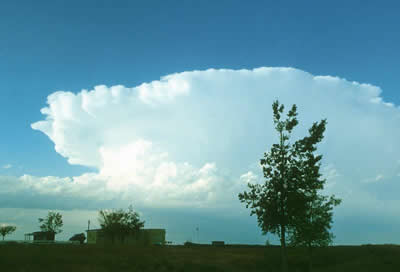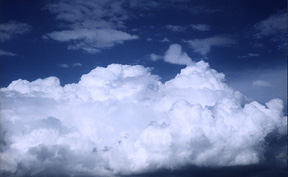Picture of a May 11, 1991, tornado in Cimarron County, Oklahoma
Click on image for full size
Greg Stumpf
Tornadoes
Tornadoes form from severe thunderstorms. They have a very high energy density which means that they affect a small area but are very destructive to that area. They also don't last very long which makes it hard to learn about them. Since they're hard to study, they're also hard to forecast. People know even less about tornadoes, which is why there are a lot of different myths that aren't true. Tornadoes can occur anywhere in the world. About 75% of them happen in the United States, most in an area know as Tornado Alley. There are also some other interesting facts about tornadoes. People who are interested in tornadoes sometimes become trained tornado spotters for their community. Others chase tornadoes, either to research these incredible storms, or to photograph them. After a tornado touches down, scientists try and figure out how strong it was by using the Enhanced Fujita Tornado Scale.
You might also be interested in:

A tornado begins in a severe thunderstorm called a supercell. A supercell can last longer than a regular thunderstorm. The same property that keeps the storm going also produces most tornadoes. The wind
...more
Thunderstorms are one of the most thrilling and dangerous types of weather phenomena. Over 40,000 thunderstorms occur throughout the world each day. Thunderstorms form when very warm, moist air rises into
...more
The land in the central United States is the best breeding ground for the storms which produce tornadoes. The land in the Great Plains is relatively flat, which allows cold dry polar air from Canada to
...more
Scientists are using information they have from past volcanic eruptions to better understand strong volcanic plumes. They have observed that in some volcanic eruptions, there is a spontaneous formation
...more
A supercell thunderstorm is a huge rotating thunderstorm. It can last for several hours as a single storm. These storms are the most likely to produce long-lasting tornadoes and baseball-sized hail. Tornadoes
...more
Cumulonimbus clouds belong to the Clouds with Vertical Growth group. They are generally known as thunderstorm clouds. A cumulonimbus cloud can grow up to 10km high. At this height, high winds will flatten
...more
There are two main types of thunderstorms: ordinary and severe. Ordinary thunderstorms are the common summer storm. Ordinary thunderstorms last about one hour. The precipitation associated with them is
...more














